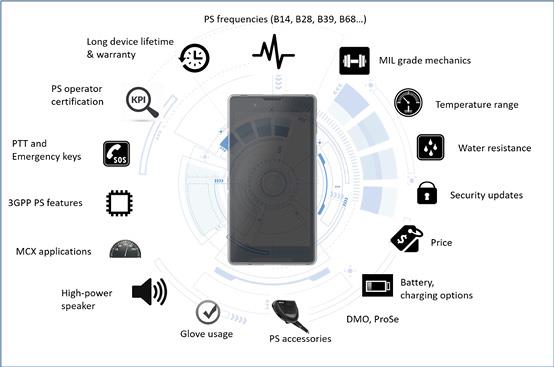14 December 2022

Tim Clark, TCCA Board member
Today’s mission-critical user devices are still mostly built on narrowband technologies such as TETRA and provide mission-critical voice and short messaging services. These services are often available within nationwide network coverage, utilising dedicated frequency bands. The narrowband critical communications device ecosystem is well established, including infrastructure and terminal suppliers, system integrators, service providers and resellers. From a device procurement perspective, there are existing frame agreements in place. The solution costs are well known, device lifecycles are long, and there are no major changes in the product specifications. Finally, TCCA’s TETRA interoperability (IOP) process allows for multi-vendor procurement.
Now, as the critical communications sector is looking to adopt broadband 4G and 5G communication technologies, there are several issues that need to be considered. In addition, from the procurement perspective, the transition to mission-critical broadband will require a series of well-planned steps. Bringing devices to market that support these new technologies, and meet various critical user requirements, will need investments by the vendors, as well as commitment from customers in terms of development support, minimum order quantities, user testing and acceptance, etc. Many current procurement models also allow device purchases from other sources. User organisations can run their own procurements, broadband devices can be leased from IT service companies, or even purchased by individual employees (BYOD - Bring Your Own Device).
Device and OS/software lifecycles of broadband devices are short compared to narrowband radios, even though vendors are doing their best to extend them. The current procurement, testing, certification, and approval processes required for mission-critical usage therefore need to be adapted accordingly. At the same time, the vendors must be able to provide information on their existing capabilities and present a roadmap that shows how they plan to meet the evolving customer needs and requirements throughout the contract period. As in any change there is room for improving the status quo.
An essential part of creating a mission-critical device procurement specification is to fully understand the user needs. The user community will consist of multiple groups, each with its specific requirements and operational processes. Once the distinct user groups have been identified, close engagement will be necessary to fully understand their use cases and device requirements. This may be achieved via interviews, questionnaires, workshops, etc. It is likely that the diverse needs can be grouped to simplify analysis. When describing their use cases and requirements it is important that the user groups look ahead to how the new broadband technology can transform and enhance their operations. Functionality delivered by existing narrowband systems is the reference, but users should not just focus on replicating the voice and messaging functionality and reliability of their existing system. The evolution from a voice-centric to a data-dominated working environment requires considerable investment in business process redesign.
With the development of mission-critical mobile broadband solutions for PPDR based on 3GPP standards, the international critical communications community has entered a new world of needs and possibilities for their user organisations. This new world has a lot of potential to support the work of critical users to make them more efficient, but also to provide more security for the users of mission-critical services. One of the key elements in the chain of information is the device that will be used to unlock the new possibilities.
The mobile broadband world is a complex one. To be able to use the functional possibilities in the most effective way, some key elements should be considered before device procurement can lead to a successful outcome. These include functional needs, technical conditions, end to end testing, user, and equipment management and of course security. Regardless of the procurement model these key elements should be well defined.
However, it should be noted that the more variety and freedom that lies with the users, the more risk there is that the end-to-end mission-critical functionalities cannot be guaranteed by the operator of the mission-critical network. Therefore, it is recommended to set up a robust system with standard set of device requirements and settings, as well as an approved device catalogue process to ensure a guaranteed level of quality for the end user.
The world of mission-critical smart devices is still developing and not yet fully mature. The ecosystem compared to standard smartphones is still small. It is therefore very important that PPDR organisations, manufacturers, standardisation, and testing bodies cooperate to stimulate the growth and development of the mission-critical device market. It is expected that the mission-critical device ecosystem will reach a mature level in the coming years.
This article is taken from TCCA’s white paper ‘Mission-Critical Broadband Device Procurement’. The aim of the white paper is to provide a holistic overview of critical broadband device-related requirements, to list the main topics and issues to be considered, as well as provide recommendations for a successful procurement, and is therefore particularly relevant to public safety organisations who are planning new device procurements.








